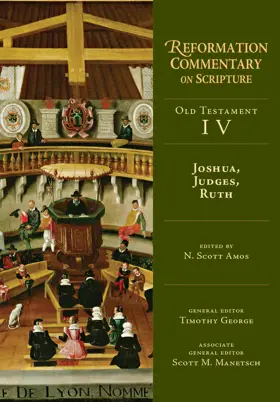

Joshua, Judges, Ruth
in Reformation Commentary on Scripture
Pages
450
Publisher
IVP Academic
Published
4/21/2020
ISBN-13
9780830829545
The Reformers of the sixteenth century found theological significance in Old Testament narratives such as Ruth's response to her mother-in-law Naomi. In this volume of the Reformation Commentary on Scripture, N. Scott Amos guides readers through a wealth of early modern commentary on the Old Testament books of Joshua, Judges, and Ruth.
Collections
This book appears in the following featured collections.
- Pre-Modern Commentaries by Matt Quintana
Reviews
The breadth and depth of commentaries available to us are astounding. There are exegetical, homiletical, pastoral, devotional, textual, and grammatical commentaries. There are commentaries on cultural backgrounds and historical context, not to mention biblical context and a host of others. And the beauty is that almost every one of these has at least something helpful to offer the church. We should be thankful for good commentaries. And here’s a new one to add to the shelf, the Reformation Commentary on Scripture: Joshua, Judges, and Ruth. Edited by N. Scott Amos (PhD, University of St. Andrews), this is volume four in the Reformation Commentary on Scripture Old Testament series from IVP Academic.
The Reformation Commentary on Scripture has four stated goals for exposing modern readers to the writings of the Reformation.
1. To enrich our contemporary interpretation of Scripture
2. To enrich our contemporary preaching
3. To enrich our understanding of the Reformation
4. To enrich Christian scholarship
To be clear, this commentary meets these goals. You will find that Amos has performed a wonderful service by selecting and categories the best of the writings of the Reformation. This collection of excerpts of primary sources will assist the careful reader with interpretation, preaching, scholarship, and in their overall understanding of the Reformation.
So here’s what you will find when you crack the cover. The layout is intuitive. Scripture is presented pericope by pericope so readers can have the ESV text right in front of them without having to simultaneously read from their Bibles. After the periscope, a helpful and concise summary follows that pulls together the major threads of the reformers’ comments. And then you get the actual comments from the reforms arranged under their topical headings.
The introductory material throughout is quite good. The general introduction to the series, the introduction to this volume, and the introductions to each book are all helpful and interesting in their own right. Understanding the Reformation is nice, and this book will no doubt help you do it. But, ultimately, my primary interest is how this book can help me study and teach God’s Word. What does it offer for the preacher and Bible student?
A pretty wide breadth of benefit actually. Personally, I was most interested in what this commentary has to say on the book of Ruth. I’ve been preaching through this book and thought this might be helpful for the business of sermon crafting. And what I found is that the reformers were asking a lot of the same questions in their day that we’re asking in ours. There’s an awareness of some of the same interpretive difficulties such as ironing out the genealogy at the end of the book. There’s some creative problem solving as seen in an interesting theory on the significance of the sandal. Some issues are more obscure than others. For example, “Did Ruth Give Thanks to God for Her Food?” (500). I don’t think I ever would have thought to ask that. This is a question I might expect one of my children to ask me. But Edward Topsell asked. And his ruminations are actually pretty edifying.
I was impressed with the rich understanding of God’s Word these men possessed. And was equally impressed with their clear desire to make it clear to others for the edification of the church and the glory of God. As to be expected, you’ll encounter some heavy allegorical and typological interpretations. Take, for instance, the view of Martin Borrhaus “The Harvest of the Gospel Prefigured” (ironically, again on p. 500). The harvesters are apostles, the harvest symbolizes the spread of the gospel, Ruth is the gleanings. Allegorical stuff like that is a bit much for my interpretive sensibilities, although it does open a window through which we can see reformation exegesis.
In short, this would be a resource I would gladly turn to after I’ve done my own exegesis. I’m not even Reformed. But we should all be able to see the wisdom in considering the contributions of men throughout history who lived, breathed, and mulled over God’s Word. Amos has done us a great service by preserving the fruits of their labor.
Thanks to IVP Academic for providing me with a digital review copy of this book. This did not influence my thoughts regarding the work.
[Full Review]
